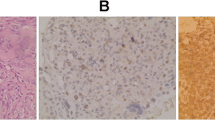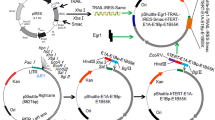Abstract
The p53 gene is a tumor suppressor gene. It encodes a nuclear phosphoprotein p53 involved in the regulation of cell cycle arrest and apoptosis to maintain the genomic integrity of the cell. As mutations of p53 gene are found in most human cancers, p53 protein becomes a hot target in the research of anticancer therapy. In the present study, an 11-amino acid domain of TAT protein which has been demonstrated to be able to transduce across cell membranes was fused with p53. The result revealed that the fusion protein His-TAT-p53 accumulated in the nucleus and inhibited the growth of the Saos-2 cells. Besides apoptosis, an increased percentage of G2 phase suggested that the transduction of His-TAT-p53 into cells might be associated with a G2 arrest of cell cycle.





Similar content being viewed by others
References
Baker SJ, Fearon ER, Nigro JM et al (1989) Chromosome 17 deletions and p53 gene mutations in colorectal carcinomas. Science 244:217–221
Greenblatt MS, Bennett WP, Hollstein MC et al (1994) Mutations in the p53 tumor suppressor gene: clues to cancer etiology and molecular pathogenesis. Cancer Res 54:4855–4878
Arnold JL (1997) p53, the Cellular Gatekeeper for Growth and Division. Cell 88:323–331
Kussie PH, Gorina S, Marechal V et al (1996) Structure of the MDM2 oncoprotein bound to the p53 tumor suppressor transactivation domain. Science 274:948–953
Vogelstein B, Lane DP, Levine AJ (2000) Surfing the p53 network. Nature 408:307–310
Wahl GM, Carr AM (2001) The evolution of diverse biological responses to DNA damage: insights from yeast and p53. Nat Cell Biol 3:E277–E286
Lin T, Chao C, Saito S et al (2005) p53 induces differentiation of mouse embryonic stem cells by suppressing Nanog expression. Nat Cell Biol 7:165–171
May P, May E (1999) Twenty years of p53 research: structural and functional aspects of the p53 protein. Oncogene 18:7621–7636
Seruca R, David L, Holm R et al (1992). P53 mutations in gastric carcinomas. Br J Cancer 65:708–710
Bosari S, Viale G (1995) The clinical significance of p53 aberrations in human tumours. Virchows Arch 427:229–241
Pellegata NS, Ranzani G.N (1996) The significance of p53 mutations in human caners. Eur J Histochem 40:273–282
Hollstein M, Sidransky D, Vogelstein B et al (1991) p53 mutations in human cancers. Science 253:49–53
Bykov VJ, Selivanova G., Wiman KG (2003) Small molecules that reactivate mutant p53. Eur J Cancer 39:1828–1834
Yuzuru H, Jun-ichi A, Jun M et al (2002) Adenoviral p53 gene therapy in head and neck squamous cell carcinoma cell lines. Oncol Rep 9:1233–1236
Blagosklonny MV, el-Deiry WS (1996) In vitro evaluation of a p53-expressing adenovirus as an anti-cancer drug. Int J Cancer 67:386–392
Green M, Loewenstein PM (1988) Autonomous functional domains of chemically synthesized human immuneodeficiency virus Tat transactivator protein. Cell 55:1179–1188
Frankel AD, Pabo CO (1988) Cellular uptake of the Tat protein from human immunodeficiency virus. Cell 55:1189–1193
Fawell S, Seery J, Daikh Y, et al (1994) Tat-mediated delivery of heterologous proteins into cells. Proc Natl Acad Sci USA 91:664–668
Hikaru N, Adamina M Vocero-Akbani, Eric LS et al (1998) Transduction of full-length TAT fusion proteins into mammalian cells: TAT-P27Kip1 induces cell migration. Nat Med 4:1449–1452
Park J, Ryu J, Kim KA et al (2002) Mutational analysis of a human immunodeficiency virus type1 Tat protein transduction domain which is required for delivery of an exogenous protein into mammalian cells. J Gen Virol 83:1173–1181
Li HJ, Jae HB, Won SE et al (2001) Transduction of human catalase mediated by an HIV-1 TAT protein basic domain and arginine-rich peptides into mammalian cells. Free Radic Biol Med 31:1509–1519
Kwon HY, Eum WS, Jang HW et al (2000) Transduction of Cu, Zn-superoxide dismutase mediated by an HIV-1 Tat protein basic domain into mammaliam cells. FEBS Lett 485:163–167
Stefan B, Silke H, Johannes B (2002) Refolding and structural characterization of the human p53 tumor suppressor protein. Biophys Chem 96:243–257
Jiyoon R, Hak JL, Kyeong-Ae K et al (2004) Intracellular delivery of p53 fused to the basic domain of HIV-1 Tat. Mol Cells 17:353–359
Veronique AJS, Rob K, Tea V et al (2000) p21 Inhibits Thr161 phosphorylation of Cdc2 to enforce the G2 DNA damage checkpoint. J Biol Chem 275:30638–30643
Ricardo LP, Dagmar K, Melina MR et al (2004) Delivery of proteins and peptides into live cells by means of protein Transduction domains: potential application to organ and cell transplantation. Transplantation 77:1627–1631
Brooks H, Lebleu B, Vives E (2005) Tat peptide-mediated cellular delivery: back to basics. Adv Drug Deliv Rev 57:559–577
Kramer SD, Wunderli-Allenspach H (2003) No entry for TAT (44–57) into liposomes and intact MDCK cells: novel approach to study membrane permeation of cell-penetrating peptides. Biochim Biophys Acta 1609:161–169
Acknowledgments
We would like to thank Dr. Zhang Xin (The Chinese National Human Genome Center, Shanghai.) for providing pcDNA3.1-p53 and the human osteogenic sarcoma cell line (Saos-2). We gratefully acknowledge the technical contributions of the colleagues in the Biochemistry Institute of East China University of Science and Technology. The work was supported by the grant from the Ministry of Science and Technology (2004AA2Z3801), P. R. China.
Author information
Authors and Affiliations
Corresponding author
Rights and permissions
About this article
Cite this article
Jiang, L., Ma, Y., Wang, J. et al. The transduction of His-TAT-p53 fusion protein into the human osteogenic sarcoma cell line (Saos-2) and its influence on cell cycle arrest and apoptosis. Mol Biol Rep 35, 1–8 (2008). https://doi.org/10.1007/s11033-006-9044-4
Received:
Accepted:
Published:
Issue Date:
DOI: https://doi.org/10.1007/s11033-006-9044-4




